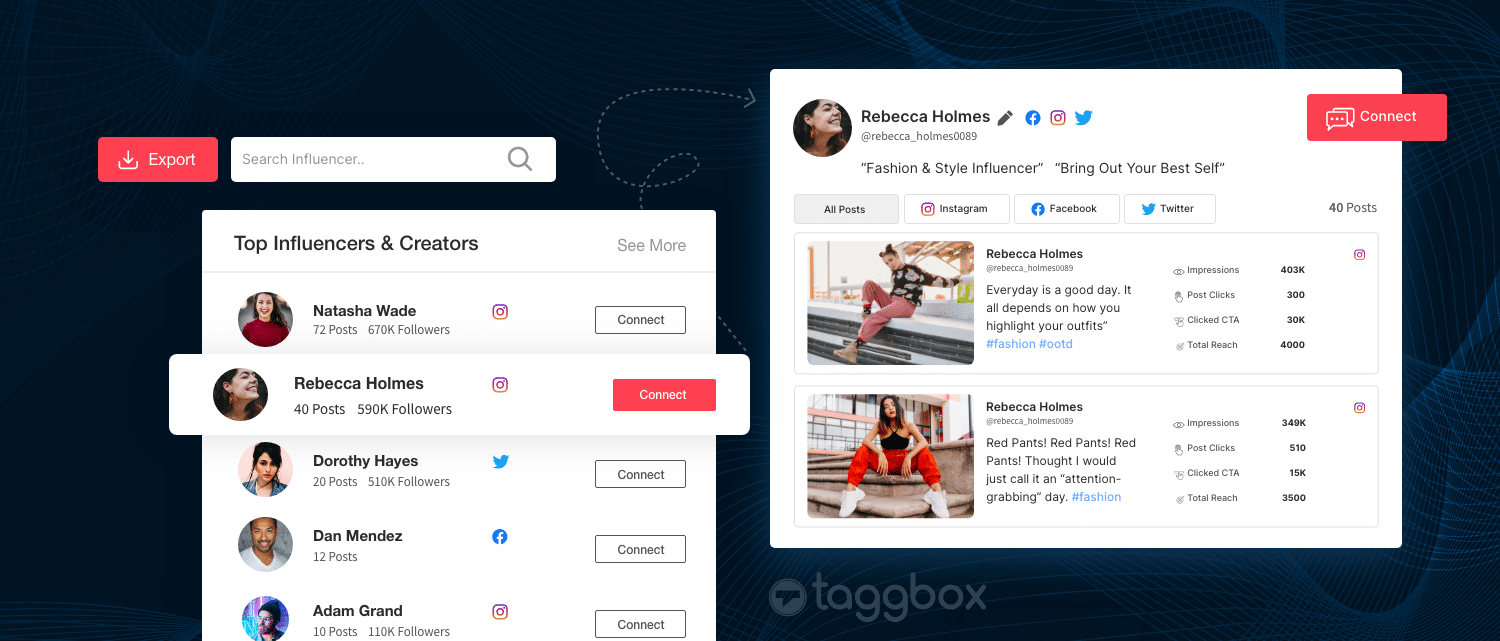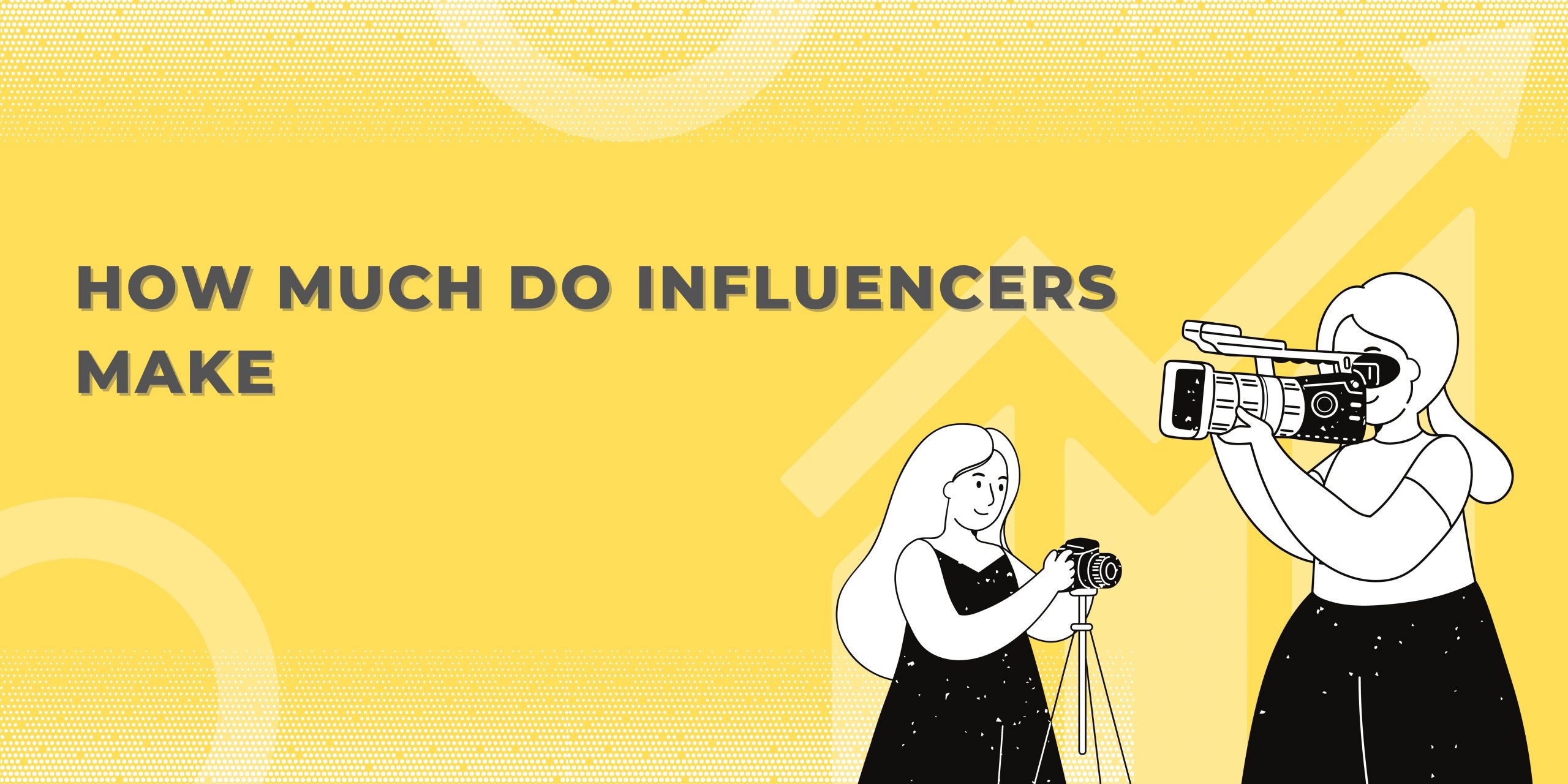Remember when everyone on our TikTok ‘For You’ page was doing their makeup while holding Crocs? It seemed strange, right?
Benefit Cosmetics kicked off this trend by teaming up with influencer Manny Mua. Soon, the whole world joined in, making it a big trend that did well. Even though it was weird for us, it was a massive success for the brand, bringing in a lot of money for their new products. This shows how influencer marketing can boost your marketing efforts and make your returns much bigger.
Influencer marketing is a dynamic strategy that has redefined how brands connect with their audiences. In fact, according to a study by Social Shepherd, it was found that 61% of Consumers Trust influencer recommendations; meanwhile, only 38% trust branded social media content.”

What is Influencer Marketing?
The term “influencer” originates in the noun “influence,” tracing back to Latin and Middle English. Emerging in the late 20th and early 21st centuries, it describes individuals who wield considerable sway on influencer platforms due to their expertise, credibility, and authenticity.
So what is Influencer Marketing? Influencer marketing is a strategy where brands collaborate with popular individuals on social media, known as influencers, to promote their products or services to a wider audience. These influencers have a dedicated following, and their endorsement helps brands reach and engage with potential customers in an authentic and relatable way.
17% of marketers plan to invest in influencer marketing for the first time in 2024
As Social media influencer marketing gained prominence, “influencer” became widely recognized in the digital and social media realms, encapsulating the dynamic force that individuals exert on the choices and actions of their audience.
Tracing Back “Influencer Marketing” Through the Years:
1. Celebrity Endorsements: The Birth of Influencer Marketing
The roots of influencer marketing can be traced back to the early days of advertising when brands began collaborating with celebrities to promote their products.
Iconic figures like Marilyn Monroe endorsing beauty products or athletes supporting sports brands laid the foundation for influencer marketing.
This initial form of influencer marketing relied heavily on celebrities’ star power and reach.
2. Digital Era and the Rise of Bloggers:
With the advent of the internet, influencer marketing started to take new forms. The early 2000s witnessed the emergence of bloggers who established themselves as trusted sources of information.
Brands recognized the potential of these bloggers to connect with niche audiences and started collaborating with them to promote products and services.
This marked a shift from traditional celebrities to individuals with specific expertise and loyal followings.
3. The Social Media Explosion:
The real turning point in influencer marketing came with the rise of social media platforms like Facebook, Instagram, Twitter, and YouTube. These platforms allowed individuals to amass large followings based on their content and personal brand.
As a result, influencers were born. These organic influencers could be anyone – lifestyle influencers, beauty experts, gamers, and foodies.
4. The Short Form Video Bandwagon:
This was when, one fine day, those lengthy YouTube videos with an intro and an outro became a thing of the past, and there was the advent of short-form videos, thanks to TikTok.
Since then, the time of video content and our attention spans have decreased. Then came Instagram reels and other socials supporting short-form content, which has been a pivotal movement in the world of social media and influencer marketing. According to a study done by The Leap, “73% of consumers prefer to watch a short-form video to learn about a product or service.”
Adding to this trend, use of tools like an Instagram engagement rate calculator has further fueled the focus on short-form content. These tools allow users and brands to analyze the performance of their Reels and other content, measuring factors like likes, comments, shares, and reach within a specific timeframe. This data helps them understand what resonates with their audience and refine their content strategy to achieve better engagement.
Does Your Brand Need Influencer Marketing?
To answer this question, I have a few questions for you:
- Looking to increase brand visibility?
- Hoping to boost brand credibility?
- Eager for more engaging social networks?
- All of this without breaking the bank?
If you answered yes to any of these, then Influencer Marketing is a resounding YES for your brand.
I’ve been chatting with marketers from all over, and one thing’s clear: Influencer Marketing is a real powerhouse when done right. In every conversation, a few key benefits kept popping up. Here they are:
- Increased Brand Visibility: Influencers can significantly expand a brand’s reach by exposing it to its dedicated and often sizable follower base, enhancing brand visibility in a way that traditional advertising struggles to achieve. They can also share your product, services, and promotion links using their digital business cards, further increasing your brand reach.
- Enhanced Credibility and Trust: Influencers are seen as authentic and trustworthy figures by their followers. When they endorse a product or service, it carries a sense of credibility that can positively impact consumer trust.
- Targeted Audience Engagement: Carefully chosen influencers can help brands reach a specific target audience. Micro-influencers, in particular, excel in engaging niche audiences that are highly relevant to the brand’s offerings.
- Authentic Content Creation: Influencers create content that aligns with their personal brand and style, making it more relatable and authentic to their followers. This authenticity often leads to higher engagement rates.
84% of Instagram Influencers Worldwide Are Women
- Cost-Effective Marketing: Instagram Influencer marketing can be cost-effective compared to traditional advertising channels, especially when working with micro-influencers. Brands can achieve substantial ROI by leveraging influencers’ existing audiences.
- Diverse Content Formats: Influencers excel at creating various content formats, including videos, photos, blog posts, and more. This diversity allows brands to convey their message creatively across multiple channels.
- Improved SEO and Online Presence: Collaborating with influencers can generate backlinks and mentions, improving a brand’s search engine ranking and overall online presence.
- Rapid Campaign Deployment: Social media Influencer marketing campaigns can be executed swiftly, making it an agile strategy to capitalize on trends or time-sensitive promotions.
- Data-Driven Insights: Modern influencer marketing often involves data analytics tools that provide valuable insights into campaign performance. Brands can use these insights to refine their strategies and optimize ROI.
- Loyal Community: Building ongoing relationships with influencers can lead to continuous promotion and brand advocacy, fostering loyalty among influencers and their audiences.
- Global Reach: Influencers can have a global following, allowing brands to expand their reach internationally without the need for extensive market entry efforts.
Influencer Marketing isn’t all sunshine and rainbows; it comes with its own set of challenges. It makes you work for it before giving you the benefits.
Limitations of Influencer Marketing
As we are talking about Influencer marketing, It is only fair to let you in on the challenges you might face when you enter this world, but remember, once you leap over them, you’re on the path to greatness!
Here are the challenges to overcome:
1. Authenticity Concerns:
Maintaining authenticity in influencer partnerships can be tricky. If followers perceive that an influencer’s endorsement is insincere or driven solely by financial gain, it can erode trust and negatively impact the brand.
Brands should prioritize authenticity and select influencers whose values align with their own. Encourage influencers to share genuine experiences with products or services and avoid overly scripted content.
2. Influencer Controversies:
Influencers are individuals; like anyone else, they can be embroiled in controversies or scandals. Such incidents can reflect poorly on the brands associated with them.
One notable example of influencer controversy involves the well-known beauty influencer, James Charles. In 2019, he faced a significant backlash from his audience and fellow influencers due to a feud with another beauty influencer, Tati Westbrook.
Tati posted a video accusing James of betraying her trust by promoting a competing vitamin brand, which was seen as a breach of their friendship.
The controversy escalated as both influencers exchanged allegations and accusations through their YouTube channels and social media platforms. James Charles lost a substantial number of subscribers during this time, highlighting the potential risks and negative consequences that can arise from influencer conflicts and controversies in the public eye.
This is why conducting thorough background checks on potential influencers and monitoring their online presence is essential. It is also important to moderate the content that you are allowing to be shown on your marketing touchpoints.
72% of Gen Z and Millennials follow influencers on social media.
3. FTC Compliance:
The Federal Trade Commission (FTC) in the United States and similar regulatory bodies worldwide have strict guidelines regarding the disclosure of paid partnerships. Failure to comply with these regulations can result in legal consequences.
Ensure that influencers clearly disclose their paid relationships with your brand in a transparent manner. Implement clear contract language and educate influencers about the importance of compliance.
4. Unrealistic Expectations:
Brands and influencers sometimes have differing expectations about the outcomes of a campaign, such as reach, engagement, or conversion rates. Unrealistic expectations can lead to disappointment and strained relationships.
Set clear objectives and Key Performance Indicators (KPIs) at the campaign’s outset. Communicate openly with influencers about goals, deliverables, and expected outcomes to align expectations.
5. Fake Audience:
Some influencers may have a significant following composed of fake or inactive accounts, which can dilute the impact of a campaign.
Utilize data-driven tools to assess an influencer’s audience authenticity and engagement rates. Focus on collaborating with influencers who have genuine, active followers.
6. Campaign Measurement and ROI:
Measuring the ROI of influencer marketing can be complex. Determining the exact impact on sales or brand perception isn’t always straightforward.
Implement tracking mechanisms and analytics tools to monitor campaign performance. To gauge ROI, consider quantitative and qualitative metrics, such as engagement, website traffic, and sentiment analysis.
7. Saturation and Follower Fatigue:
Follower fatigue can occur when audiences are exposed to numerous sponsored posts. This can lead to decreased engagement and skepticism.
Focus on creating high-quality, value-driven content that aligns with the influencer’s authentic style. Avoid overloading the audience with promotional content and strive for a balanced mix of sponsored and non-sponsored posts.
Overwhelmed? Don’t fret. Tagbox’s Creator Community has handpicked top influencers across different industries and niches.
We’ve got you covered so you can find your ideal influencer right here without the hassle of dealing with these challenges.
Now that you are equipped with Tagbox and ready to face these challenges, let me walk you through the precise steps to make it happen.
1 in 4 marketers currently leverages influencer marketing.
How to Plan Your Influencer Marketing Strategy?
Planning an effective influencer marketing strategy requires careful consideration and strategic thinking. Nowadays, consumer trust and engagement are foremost, and influencer marketing has emerged as a powerful tool for brands to gain that.
I’ve made things easier for you by consulting with industry experts about their influencer marketing strategies and compiling a handy cheat sheet. This resource covers everything from crafting a strategy to its execution, ensuring it’s geared towards delivering results and a strong ROI. So, let’s dive right in!
1. Setting Clear Objectives and Goals:
This step involves defining your goal with your influencer marketing campaign. Objectives could include increasing brand awareness, driving website traffic, boosting sales, or enhancing brand reputation.
Clear goals provide a roadmap for your campaign and help measure its success.
2. Identifying Your Target Audience:
Understanding your target audience is crucial for influencer marketing success. It involves creating detailed buyer personas and identifying demographics, interests, and pain points.
This information helps in selecting influencers whose followers align with your ideal customers.
3. Finding and Choosing the Right Influencers:
Finding influencers that resonate with your brand and audience involves extensive research. Look for influencers whose values, content style, audience size, and demographics match your campaign objectives.
4 Establishing Key Performance Indicators (KPIs):
KPIs are measurable metrics that determine the success of your influencer marketing campaign.
Common KPIs include reach, engagement rate, conversion rate, click-through rate (CTR), and return on investment (ROI). Setting KPIs in advance ensures you can track and evaluate your campaign effectively.
5. Budgeting and ROI Considerations:
Determine your budget for the influencer marketing campaign and allocate resources wisely. ROI considerations involve estimating the potential return on investment based on your campaign objectives.
Be prepared to adjust your budget based on expected outcomes and data-driven insights.
Let’s have a look at various types of influencers based on their audience size:
Types of Influencers For Your Brand
In the realm of influencer marketing, influencers come in various audience sizes and niches. Here are the primary types of influencers:
1. Nano-Influencers:
These are individuals with a relatively small but highly engaged follower base, typically in the range of 1,000 to 10,000 followers. Nano-influencers often have a deep connection with their audience and can be effective for niche marketing.
2. Micro-Influencers:
Micro-influencers have a slightly larger following, typically between 10,000 and 1,00,000 followers. They are known for their expertise in specific niches and often have higher engagement rates than larger influencers.
Micro-influencers generate up to 60% more engagement than Macro-influencers.
3. Macro-Influencers:
These influencers have a substantial following, ranging from 100,000 to 1 million followers. They offer a broader reach and can help brands connect with a wider audience.
4. Mega-Influencers:
Mega-influencers are celebrities or public figures with millions of followers. They have a massive reach and can be especially effective for brand visibility, but their endorsements tend to be more expensive.
How to Execute a Successful Influencer Marketing Campaign
I handpicked the top brands and looked into their influencer marketing campaign plans; after analyzing them, I realized a few strategies that were common in most of them. here they are:
1. Creating Engaging Content Briefs:
Comprehensive content briefs are vital for guiding influencers in creating content that aligns with your brand’s message and goals.
These briefs should provide clear instructions, expectations, and key points while allowing room for the influencer’s creativity and unique style.
2. Maintaining Authenticity in Partnerships:
Authenticity is the cornerstone of effective influencer marketing. Brands should encourage influencers to maintain their genuine voice and style when promoting products or services.
Authenticity helps build trust with the influencer’s audience, ensuring that endorsements come across as sincere.
3. Measuring Campaign Performance:
Tracking the performance of your influencer marketing campaign is essential for evaluating its success. Use tools and analytics to monitor reach, engagement, conversion rates, and ROI metrics.
This data-driven approach allows for optimization and adjustments during the campaign.
4. Leveraging User-Generated Content:
Encourage influencers to create user-generated content (UGC) related to your brand or products.
UGC extends the campaign’s reach and provides authentic testimonials and endorsements from satisfied customers, further boosting credibility.
5. Legal and Ethical Considerations (FTC Guidelines, Contracts):
Adhering to legal and ethical standards is paramount in influencer marketing. Ensure compliance with Federal Trade Commission (FTC) guidelines and other relevant regulations.
Develop clear and legally binding contracts outlining terms, deliverables, disclosure requirements, and compensation to protect your brand and the influencer.
Executing a successful influencer campaign requires careful planning, collaboration, and adherence to ethical standards.
By creating compelling content briefs, prioritizing authenticity, measuring performance, leveraging user-generated content, and addressing legal and ethical considerations, you can run influencer campaigns that resonate with your audience and drive meaningful results.
Emerging Trends and the Future of Influencer Marketing
1. The Role of Video Content and Live Streams:
Video content, including live streams, is becoming increasingly dominant in influencer marketing. Audiences crave authentic and engaging video experiences. Influencers are leveraging platforms like YouTube, Instagram Live, and TikTok to connect with their followers in real-time.
Brands are capitalizing on this trend by partnering with influencers to create live and recorded video content that showcases products and services dynamically and interactively.
2. Niche Influencers and Hyper-Personalization:
As the influencer landscape diversifies, brands are recognizing the power of niche influencers who cater to highly specific and passionate audiences. These influencers may have smaller followings but offer hyper-personalized content that resonates deeply with their followers.
By collaborating with niche influencers, brands can tap into these engaged communities and deliver more targeted and personalized messaging.
3. The Impact of Social Commerce:
Social commerce, the integration of e-commerce with social media platforms, is reshaping influencer marketing. Influencers are not just promoting products but also facilitating direct purchases within their content.
Features like Instagram Shopping and shoppable posts enable a seamless transition from discovery to purchase, making influencer marketing an increasingly efficient sales channel.
4. The Role of AI and Data Analytics in Influencer Marketing:
Artificial intelligence (AI) and data analytics are revolutionizing influencer marketing strategies. AI-driven tools can identify potential influencers, analyze audience demographics, and predict campaign outcomes.
Data analytics provide valuable insights into influencer performance, audience behavior, and ROI. Brands are relying on these technologies to make informed decisions and optimize their influencer marketing efforts.
These emerging trends are shaping the future of influencer marketing. Video content and live streams offer dynamic engagement, niche influencers provide hyper-personalization, social commerce streamlines the purchasing process, and AI and data analytics enhance campaign effectiveness.
Staying attuned to these developments is essential for brands aiming to stay competitive and successful in the evolving influencer marketing landscape.
The Curtain Call
Influencer marketing has redefined how brands connect with audiences. With a trust level of 61%, influencers wield incredible power. It’s evolved from celebrity endorsements to today’s data-driven, diverse landscape.
Future trends like video content, niche influencers, social commerce, and AI-driven analytics promise to reshape it. This guide equips you to navigate this dynamic strategy, from understanding its roots to harnessing its benefits and overcoming challenges.
Influencer marketing is a force to be reckoned with, propelling brands to success and engagement in the digital age.
FAQs
Influencer marketing is a marketing strategy that involves partnering with individuals who have a significant and engaged online following, often referred to as "influencers," to promote a brand, product, service, or message.
The different types of social media influencers defined by follower count are: 1. Mega Influencers. 2. Macro Influencers. 3. Micro Influencers. 4. Nano Influencers.
Influencer marketing can greatly enhance your social presence by leveraging the reach, credibility, and engagement of influencers within your niche or industry.
1. Fashion and Beauty Influencers 2. Fitness and Wellness Influencers 3. Travel Influencers 4. Lifestyle Influencers 5. Gaming Influencers



